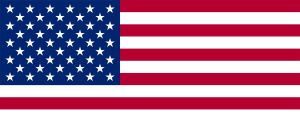In 1777, in the midst of the War of Independence, the Continental Congress adopted the Stars and stripes flag (Stars and Stripes) as the official flag of the free states of America. On this day every year, Americans decorate the house with flags, thus showing their patriotism. Special surge “Stars and Stripes” was observed in the U.S. after the sad events of September 11. The idea of an annual festival to celebrate the flag seems to date back to 1885. B.J.Sigrand, a school teacher arranged it for his students at Fredonia, in a secondary school in Wisconsin 6th District, to celebrate the 14 June (the anniversary of the approval of 108 Stars and Stripes) as ‘Flag Birthday’. In numerous articles in magazines and newspapers and personal letters in subsequent years Sigrand enthusiastically continued to promote the celebration of June 14 as “Flag Birthday” or “Flag Day”.

June 14, 1889, George Balch, a teacher of elementary grades in New York, had planned a beautiful ceremony for the children of his school, and his idea of Flag Day was later adopted by the Board of Education in New York. June 14, 1891 the city of Betsy Ross House in Philadelphia supported the celebration of Flag Day, and next year June 14, the Society of Sons of the Revolution in New York celebrated Flag Day. Following the advice of Colonel J. Granville Leach (at the time historian of the Society of the Sons of the Revolution in Pennsylvania), Society of Colonial American Communities in Pennsylvania April 25, 1893 decided to ask the mayor of Philadelphia and other authorities and ordinary citizens to celebrate Flag Day on June 14. Leach suggested that in the future to celebrate this holiday, called “Flag Day”, and on this day students convened for specific activities and every child was issued a small flag.
Two weeks later, on May 8, the Office of the Society of the Sons of the Revolution in Pennsylvania, unanimously endorsed actions of the Society of Colonial American communities in Pennsylvania. As a result of the decision, Dr. Edward Brooks, then head of the Public Schools in Philadelphia, ordered that the presentation in honor of Flag Day to be held June 14, 1883 on the Independence Square. Students were constructed, each carrying a small box, patriotic songs were sung and chanted speech. In 1894 the governor of New York decreed that the celebration of Flag Day on June 14 must be displayed on public buildings. Since that day the flags were put up on the houses to show the patriotism of citizens. Together with the B.J. Sigrand and Leroy Van Horn as the main masterminds, in Illinois there was the Organization known as Flag Day Association was founded with the purpose of campaigning and organizing the holiday. June 14, 1894 under the auspices of this organization the first Flag Day was celebrated in most public schools in the state of Chicago: in Douglas, Garfield, Hambolte, Lincoln and Washington Parks, with the participation of more than 300 thousand of children.
Adults, too, participated in patriotic programs. Franklin K. Lane, Minister of Regions, said in 1914 a speech to the Day of the Flag, in which there were the words on behalf of the flag: “I am what you made me. I swing before your eyes as a bright gleam of the light, I am a symbol of yourselves. ” Inspired by those three decades of celebrations in the States and in certain parts of the country, Flag Day – the anniversary of the approval of the Flag in 1777 – was officially proclaimed by President Woodrow Wilson on May 30, 1916. That days Flag Day was celebrated in various communities for the years after the proclamation of Wilson. Then, August 3, 1949 President Truman signed an Act of Congress, which argued June 14 as National Day of the Flag. About the Flag: 13 equal bands of red (top and bottom) alternating with white; in the upper left corner there is a blue rectangle with 50 small stars painted in such a way that the nine lines of stars alternating with six and five, with a shift by one row and 50 stars represent the 50 states, 13 stripes represent the 13 original colonies, called Old Glory ; design and color became the basis for many other flags, including Chile, Liberia, Malaysia, and Puerto Rico.

